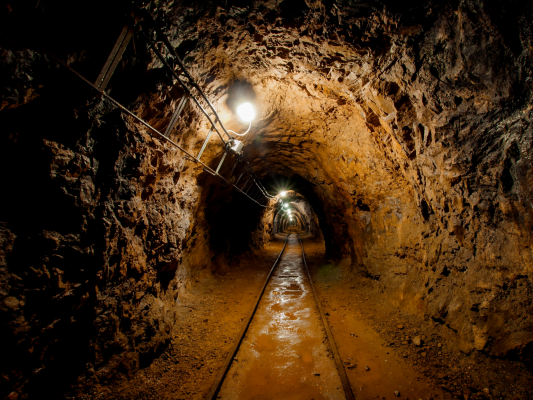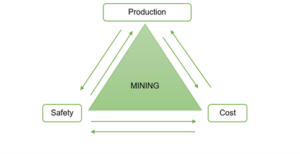Occupational Health and Safety in the ASM sector

Artisanal and small-scale mining (ASM) is a source of livelihood in Zimbabwe. It employs more than five hundred thousand workers directly and three million indirectly (Parliament Zimbabwe, 2017). However, ASM activities can damage the environment and pose health and safety risks to workers and surrounding communities. This could be attributed to poor mining and processing practices due to lack of technical knowledge.
Artisanal and small-scale miners (ASM) employ rudimentary mining methods and lack formal plans and procedures to guide their mining activities up to mine decommissioning. There are no efforts to rehabilitate mined areas. Poor mining practices include operating in shallow and highly unstable grounds, and depillaring abandoned mines. These mining practices have resulted in fatal accidents such as those reported at Globe and Phoenix Prince mine (Kwekwe), Task mine (Chegutu), and Ran mine (Bindura). Emergence preparedness and response in these accidents was considerably poor owing to low worker capacitation. Hazard identification, risk assessment and risk management are required to prevent occupational accidents.
Artisanal mining is regarded as an illegal activity in Zimbabwe (Mines and Minerals Act, 1996; Gold Trade Act, 2001; Parliament Zimbabwe, 2017). Lack of regulatory and policy framework and decent work principles prevents formalisation of this sector in Zimbabwe. This complicates improvements in safety standards, adherence to mining regulations and environmental performance.
Occupational Health and Safety (OHS) issues of ASMers are compromised. Working in confined places with poor ventilation using poor drilling technologies exposes ASMers to upper respiratory diseases such as silicosis. Injuries, fatalities and disabilities have been reported among this category of workers. Cases of HIV/AIDS and Sexually Transmitted Infections (STIs) are prominent due to inadequate f health facilities and low levels of awareness and risk perception. All these OHS and environmental issues discourage sustainability of mining operations.
An average of 60 workers die in the artisanal and small-scale mining (ASM) sector every year. Miners often suffer from occupational diseases such as pneumoconiosis and tuberculosis. Also work-related injuries, fatalities and disabilities occur from collapse of ground due to poor mine design and at times flooding, accidental detonation of explosives and inundation. Apart from devastating effects on workers, mining has environmental effects. For example, use of hazardous chemicals such as cyanide and mercury which often find their way into the aquatic environment, affects ecosystem health. Mining operations may leave behind degraded landscape.
It is consequently imperative to prevent incidents and occupational health problems in the mining communities and promote sustainable mining development. Management at ASM need to prioritise safety of workers and quality of the environment. As guided by Statutory Instrument (S.I) 109 (Mining (Management and Safety)), mine managers need to approve safety standards and enforce safe practices at mine sites. Mining teams should be dedicated to conducting mining responsibly to protect people, property and the environment. They should comply with applicable SHEQ laws and policies, Standard Operating Procedures (SOPs), SHEQ plans, and set SHEQ leading and lagging performance targets and indicators. Scheduled inspections, Task performance observations, SHEQ audits and risk assessments, and trainings are also helpful in strengthening and improving compliance with SHEQ requirements. The provision of SHEQ related information, and training ensures that all workers:
- are not injured or fall ill by the work they do.
- develop a positive SHEQ culture where they become second nature to everyone.
- find out how one could improve SHEQ issues and production in the confinement of mining costs.
- meet all relevant applicable legal SHEQ obligations.
Importance of safety, health, environment, and quality management issues
All workplaces have the legal obligations to conduct their production activities with safety in mind. Adherence to recommended SHEQ standards promotes environmental sustainability and ensures that everyone comes to work and goes back home safely every day. It means safe uninterrupted production. This is good to fend for one’s family. SHEQ standards and practices ensure that the social license will be intact throughout the mining life cycle. Safety management practices are a crucial component of the mining operations and are part of the three pillars where mining stands on, and these include production, cost, and safety.
Three Pillars of mining
A mining operation generally rests on three interacting pillars: safety, production, and cost (Fig. 1).


Fig. 1. Three pillars of mining (Source: Zimbabwe Environmental Law Association)
The three pillars are the balancing factors at any mining operation. A safe production model ensures that the three pillars are balanced and there is no over emphasis of one of the pillars. Compromising safety will influence both production and cost. The three-pillar model suggests that putting more emphasis on production would mis-balance safety and this will have an overall cost overrun. The mismanagement in any of the pillars will result in over-expenditures through either loss in production, high emergency response costs, hospital bills or mine rehabilitation costs.
Safety, health, environment and quality management (SHEQ) practices
SHEQ practices foster safe production at a mine site. Priority should be put on factors that ensure a vibrant SHEQ practice in ASM sector. Sound SHEQ practices are comprise of standards, procedures, communication and compliance.
Standards and procedures
Communication
Communication means interactive dissemination of all SHEQ issues and performance standards with miners, management and other relevant stakeholders. Effective communication is interactive, informative, positive and productive. Communicating OHS information effectively is crucial to prevent work-related diseases, injuries and fatalities. The message should get across to all miners. Communication is done through crew or toolbox meetings, work site visits, staff meetings, management review meetings and safety bulletin boards.
Compliance
Any effort to ensure a safe working environment requires stringent monitoring and enforcement. This may be done through:
- targeted and responsive inspections,
- SHEQ audits,
- a SHEQ strategy,
- disciplinary policy.
Source: ZELA


